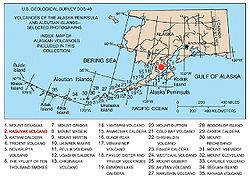
Mount Kaguyak
Encyclopedia
Mount Kaguyak is a stratovolcano
located in the northeastern part of the Katmai National Park in Alaska
. The 2.5 km wide caldera
is filled by a more than 180 m deep crater lake
. The surface of the crater lake lies about 550 m below the rim of the caldera. Postcaldera lava dome
s form a prominent peninsula in the center of the lake. Even though the volcano is only 901 m high it is spectacular, because it rises from lowland areas near sea level in the south of the Big River.
Based on radiocarbon dating
the caldera-forming eruption occurred about 5800 years before present
. During this eruption at least 120 square kilometers were covered in a dacitic ignimbrite
.

Stratovolcano
A stratovolcano, also known as a composite volcano, is a tall, conical volcano built up by many layers of hardened lava, tephra, pumice, and volcanic ash. Unlike shield volcanoes, stratovolcanoes are characterized by a steep profile and periodic, explosive eruptions...
located in the northeastern part of the Katmai National Park in Alaska
Alaska
Alaska is the largest state in the United States by area. It is situated in the northwest extremity of the North American continent, with Canada to the east, the Arctic Ocean to the north, and the Pacific Ocean to the west and south, with Russia further west across the Bering Strait...
. The 2.5 km wide caldera
Caldera
A caldera is a cauldron-like volcanic feature usually formed by the collapse of land following a volcanic eruption, such as the one at Yellowstone National Park in the US. They are sometimes confused with volcanic craters...
is filled by a more than 180 m deep crater lake
Crater lake
A crater lake is a lake that forms in a volcanic crater or caldera, such as a maar; less commonly and with lower association to the term a lake may form in an impact crater caused by a meteorite. Sometimes lakes which form inside calderas are called caldera lakes, but often this distinction is not...
. The surface of the crater lake lies about 550 m below the rim of the caldera. Postcaldera lava dome
Lava dome
|250px|thumb|right|Image of the [[rhyolitic]] lava dome of [[Chaitén Volcano]] during its 2008–2009 eruption.In volcanology, a lava dome is a roughly circular mound-shaped protrusion resulting from the slow extrusion of viscous lava from a volcano...
s form a prominent peninsula in the center of the lake. Even though the volcano is only 901 m high it is spectacular, because it rises from lowland areas near sea level in the south of the Big River.
Based on radiocarbon dating
Radiocarbon dating
Radiocarbon dating is a radiometric dating method that uses the naturally occurring radioisotope carbon-14 to estimate the age of carbon-bearing materials up to about 58,000 to 62,000 years. Raw, i.e. uncalibrated, radiocarbon ages are usually reported in radiocarbon years "Before Present" ,...
the caldera-forming eruption occurred about 5800 years before present
Before Present
Before Present years is a time scale used in archaeology, geology, and other scientific disciplines to specify when events in the past occurred. Because the "present" time changes, standard practice is to use AD 1950 as the origin of the age scale, reflecting the fact that radiocarbon...
. During this eruption at least 120 square kilometers were covered in a dacitic ignimbrite
Ignimbrite
An ignimbrite is the deposit of a pyroclastic density current, or pyroclastic flow, a hot suspension of particles and gases that flows rapidly from a volcano, driven by a greater density than the surrounding atmosphere....
.

Sources
- http://www.springerlink.com/content/p7320l57357p1113/
- Volcanoes of the Alaska Peninsula and Aleutian Islands-Selected Photographs
- Alaska Volcano Observatory

